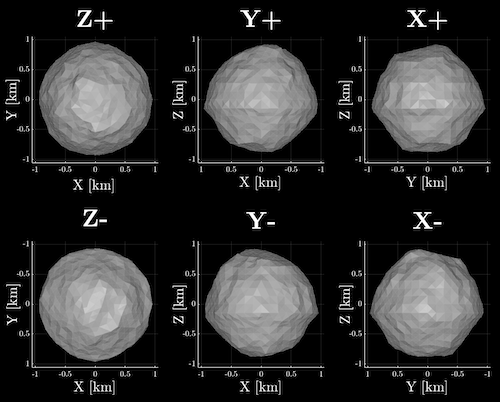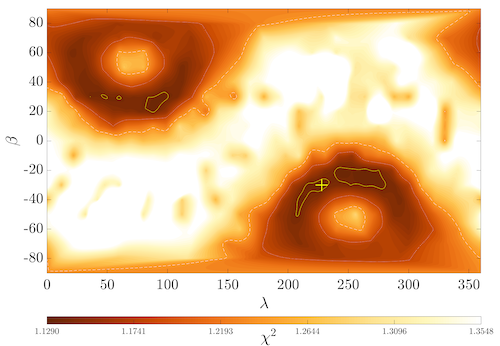Physical modelling of YORP-evolved NEA (23187) 2000 PN9 from optical and radar observations
- 1Centre for Astrophysics and Planetary Science, University of Kent, Canterbury, UK (lrd27@kent.ac.uk)
- 2Institute for Astronomy, University of Edinburgh, Edinburgh, UK
- 3The Open University, UK
- 4Planetary Sciences Institute, Tucson, Arizona, USA
- 5Institute of Astronomy, V. N. Karazin Kahrkiv National University, Kharkiv, Ukraine
- 6Planetary Science Section, Jet Propulsion Laboratory / Caltech, USA
Abstract
We are conducting an observing campaign with a sample of near-Earth asteroids (NEAs) to detect YORP-induced acceleration. Photometric lightcurves from small to medium optical telescopes are used to detect changes to spin state. Where available, radar and thermal-IR observations are used to develop physical models that are used to determine expected YORP strengths. We will present the results of an analysis of 2000 PN9 (hereafter PN9) using optical and radar observations between 2001 and 2016. A detailed physical model has been developed to describe the shape and spin-state of the asteroid. PN9 is top-shaped with an equatorial ridge, and is rotating close to the spin-breakup limit. PN9 is the largest asteroid known to have this distinctive and highly symmetrical 'YORPoid' shape, and is the fastest-rotating top-shaped body that is not part of a multiple system. Due to the size and shape of PN9, an observational detection of YORP acceleration has not been possible with the available data. The shape and rotation period indicate that PN9 is a YORP-evolved body similar to 1999 KW4 [1], and that it is a good candidate for future detection of mass-lofting events.
Introduction
The YORP effect is a thermal torque caused by the reflection, absorption and anisotropic re-emission of Solar radiation [2,3]. YORP is the main driver of physical and dynamical evolution for small bodies in the inner Solar System [4]. There are seven confirmed detections of YORP to date, all of which are in the 'spin-up' mode.
The observing campaign aims to increase the number of YORP detections such that theoretical understanding of YORP can be improved. Optical and IR observations were carried out on 42 NEAs through our ESO Large Programme from 2010 to 2014, with continued monitoring conducted through associated programmes. In addition to photometric observations, thermal-IR and radar observations have been obtained for the NEA sample.
PN9 was observed in 2001, 2006, 2010, 2011, 2015 and 2016 with various optical telescopes resulting in 29 lightcurves. Radar observations were also conducted at the Arecibo and Goldstone radar facilities in 2001 and 2006. Previously published lightcurves report rotational periods around 2.53 h [5,6] and initial diameter estimates range from 1.6 - 2.0 km [5,7]. PN9 has been previously classified as an Sq-type asteroid [8].
Results & Conclusions
Detecting YORP requires well constrained measurement of the evolving rotation period and pole orientation. These parameters can be determined using lightcurve data alone, although it is beneficial to have a detailed radar shape model. This greatly assists with the computation of rotational phase offsets between observations and synthetic lightcurves derived from a constant-period shape model. YORP causes a linear change in rotation period, which in turn causes a quadratic increase in rotational phase offset against time. A radar shape model greatly assists in the detection of this quadratic trend, which is highly desirable for constraining YORP strength.

Figure 1: Shape model for asteroid 2000 PN9 developed using both radar and lightcurve observations. The top row shows the model from the positive end of the Z, Y and X axes in the body-centric co-ordinate system. The bottom row shows the model from negative end of the Z, Y and X axes.
Lightcurves of PN9 have very low amplitudes due to the highly symmetrical nature of the object. Lightcurve data alone was not sufficient to constrain the orientation of the rotational axis, so the spin-state was determined using a combination of lightcurve and radar data. Figure (2) shows the χ2 fit of pole solutions across the whole sky, with the pole-scan converging to two regions that are opposite each other on the celestial sphere. This pole solution degeneracy implies uncertainty as to whether the asteroid is a prograde or retrograde rotator. Physical models were generated for all possible pole solutions, with all solutions within 1% of the best solution having a shape and period consistent with the best solution. For the best-fit pole solution at λ=228° β=-30°, we have determined the sidereal rotation period to be 2.532972±0.000015 hours. In the body-centric coordinate system where the z-axis is aligned with the rotation axis, the maximum extents of the X, Y and Z axes are 1.885x1.888x1.780 km. As shown in Figure (1), the shape is highly symmetrical with an equatorial ridge. This shape is characteristic for a rapidly rotating rubble pile, where material is being migrated towards the equator [9] and closely resembles the convex hull model of 1917 Cuyo, a candidate for rotationally-induced mass lofting [10]. We have measured the circular polarisation ratio (SC/OC) to be 0.225±0.004, which is consistent with PN9's taxonomic type. We have been unable to measure YORP acceleration; the size and shape of PN9 results in a low expected YORP strength, and phase offsets cannot be precisely measured with relatively featureless lightcurves.
Further work that will be presented at the meeting includes an updated physical model developed with newly obtained lightcurves, and an update on Spitzer thermal-IR lightcurves of PN9.

Figure 2: The results of a search for the rotational pole of 2000 PN9 using radar and lightcurve data. The best solution is marked with a yellow '+'. The yellow and white lines enclose regions where χ2 is within 1% and 5% of the best solution respectively.
Acknowledgements
The authors would like to thank A. Fitzsimmons, R. Ya. Inasaridze, V. A. Ayvazian, V. V. Rumyantsev, V. G. Chiorny, I. V. Reva, M. A. Krugov, I. E. Molotov, M. W. Busch, M. C. Nolan, A. A. Hine, V. Negrón, L. A. M. Benner and M. D. Hicks for their contributions to this work.
References
[1] Ostro, S. J. et al. (2006) Science 314, 1276. [2] Rubincam, D. P. (2000). Icarus 148, 2. [3] Lowry, S. C. et al. (2007). Science 316, 272. [4] Bottke, W. F. et al. (2006). AREPS 34. [5] Belskaya, I. N. et al. (2009). Icarus 201, 167. [6] Warner, B. D. (2016). Minor Planet Bulletin 43, 240. [7] Busch, M. W. et al. (2006). Society for Astronomical Sciences Annual Symposium 25, 169. [8] Thomas, C. A. et al. (2014). Icarus 228, 217. [9] Walsh, K. J. et al. (2008). Nature 454, 188. [10] Rożek, A. et al. (2019) A&A 627, A172.
How to cite: Dover, L., Lowry, S., Rożek, A., Zegmott, T., Rozitis, B., Green, S., Snodgrass, C., Weissman, P., Krugly, Y., Belskaya, I., and Brozović, M.: Physical modelling of YORP-evolved NEA (23187) 2000 PN9 from optical and radar observations, Europlanet Science Congress 2020, online, 21 Sep–9 Oct 2020, EPSC2020-825, https://doi.org/10.5194/epsc2020-825, 2020.

